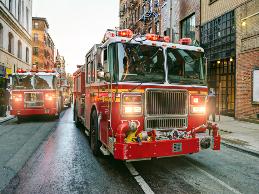Serving on the motor team for 8 years, one issue that comes up time after time is emergency evacuation plans for an employee who uses a wheelchair. Whether it’s part of an employer’s safety initiative (which includes an emergency evacuation plan for all employees) or whether an employer is concerned for the safety of a specific employee in a wheelchair, the ultimate goal is to evacuate the premises safely and in a timely manner.
As with any safety issue or concern with accommodations, an employer should talk to the employee. An employee may know exactly what they need to be safe in an emergency and/or how to get out of a building. If the employee doesn’t know what they need, then an employer can discuss the following ideas and determine if they would be feasible based on the work environment and employee’s abilities.
It has become pretty common that an employer will provide an evacuation chair to have on site in case of an emergency. An evacuation chair permits users to go down a flight of stairs safely assuming the elevator can’t be used during those times. Evacuation chairs come in a variety of shapes and sizes and usually require another person to maneuver them. It is important for both the employee using the chair and the one pushing it to be trained on its functions, harness capabilities, and path of travel.
Additionally, an employer may want to consider providing a kit for use once people are evacuated and don’t have their personal belongings. This kit can contain heavy gloves to protect the individual’s hands, a patch kit for flat tires, and extra batteries for motorized wheelchairs or scooters.
Another consideration for an employer is a Sample Plan of Action. An employee with a disability may need a more customized plan when an emergency arises, and that’s when a plan of action can come into play. These plans should be customized as a joint effort between the employer and employee. The plan may include details such as how or when to provide onsite medical assistance, if and when to call 911, and who to call from the employee’s emergency contacts. Included in the plan of action could be the designation of a person to inform emergency personnel when the employee in a wheelchair needs assistance during an evacuation. Sometimes an employee may need more assistance than what a coworker can provide, so the employer can assign that responsibility to a designated person who will communicate with the professionals who will help that employee stay safe during an emergency.
Something that comes up often when developing an emergency evacuation plan is performing semi-annual or even monthly drills, where all employees are supposed to exit the building just as they would in an emergency. For some employees who use wheelchairs, participating in a drill may be difficult and even put them more in harm’s way. As an accommodation in lieu of drill participation, an employer may want to consider permitting the employee to describe and outline what they would do in case of an emergency, ensuring that they are in fact capable of safely evacuating.
JAN consultants are always here to help you sort through any issues pertaining to emergency evacuation, so give us a call. For more information, visit JAN's A to Z by Topic: Emergency Evacuation.








